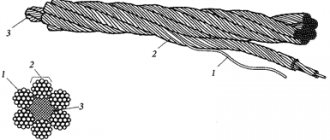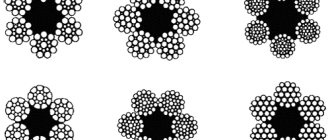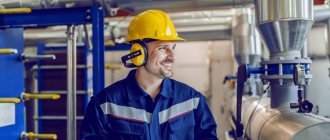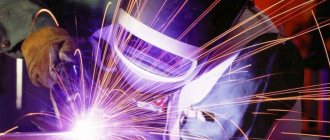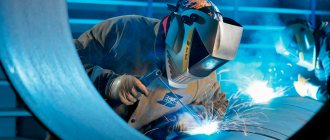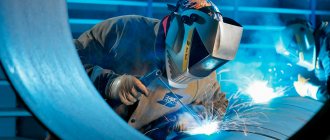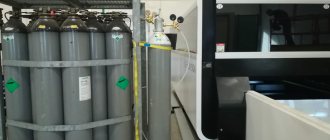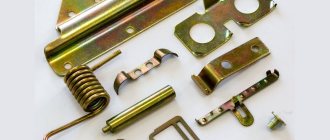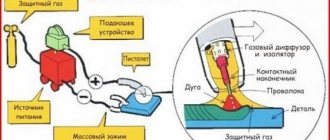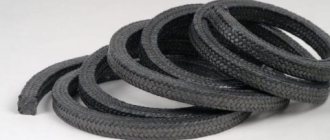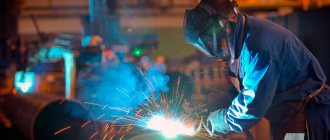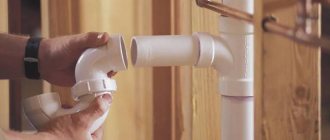Welding safety precautions contain answers on how to act in certain situations, as well as a list of restrictions and prohibitions when working with gas welding. Safety precautions for gas welding are designed to protect the welder and surrounding people from injury, and will help avoid accidents and destruction.
The welder must follow safety rules when performing work and wear personal protective equipment: overalls, gloves and a mask. Robes and mittens (gaiters) protect not only from splashes of molten metal, but also from thermal and ultraviolet radiation. The welding mask protects the eyes from retinal burns, which lead to loss of vision. It also protects the face and neck from ultraviolet radiation, infrared light and metal splashes.
GENERAL OCCUPATIONAL SAFETY REQUIREMENTS
1.1. An employee who is at least 18 years old, who has undergone a medical examination and has no contraindications for health reasons, who has the necessary theoretical and practical training, who has completed introductory and initial workplace safety briefings and training according to a special program, and who is certified, is allowed to perform work using a gas burner. qualification commission and received permission to work independently. 1.2. An employee who performs work using a gas burner (hereinafter referred to as the employee) must periodically, at least once a year, undergo training and testing of knowledge of labor protection requirements and receive permission to perform high-risk work. 1.3. An employee, regardless of qualifications and work experience, must undergo repeated training on labor protection at least once every three months; If an employee violates labor safety requirements, as well as during a break in work for more than 30 calendar days, he must undergo an unscheduled briefing. 1.4. An employee who has not undergone timely instructions and testing of knowledge of labor protection requirements is not allowed to work independently. 1.5. An employee performing work using a gas burner, who is allowed to work independently, must know: safety measures when using gas cylinders and burners. Rules, regulations and instructions for labor protection and fire safety. Rules for the use of primary fire extinguishing agents. Methods of providing first aid in case of accidents. Internal labor regulations of the organization. 1.6. An employee sent to participate in work unusual for his profession must undergo targeted training on the safe performance of the upcoming work. 1.7. An employee is prohibited from using tools, devices and equipment that he has not been trained in the safe handling of. 1.8. When performing work using a gas burner, an employee may be exposed mainly to the following dangerous and harmful production factors: - the possibility of a fire when using a gas burner; — the possibility of a gas cylinder explosion; — gas burner surfaces heated to high temperatures; - uncomfortable working position. 1.9. An employee performing work using a gas burner must be aware that during work, the most likely cause of injury may be burns from the open flame of a gas burner. 1.10. To protect against the effects of dangerous and harmful production factors, the employee must use special clothing, safety shoes and other personal protective equipment. 1.11. To prevent the possibility of a fire, the employee must comply with fire safety requirements himself and prevent other employees from violating these requirements; Smoking is permitted only in designated areas. 1.12. The employee is obliged to comply with labor and production discipline, internal labor regulations; It should be remembered that drinking alcohol usually leads to accidents. 1.13. If an accident occurs with one of the employees, the victim must be given first aid, report the incident to the manager and maintain the situation of the incident, if this does not create a danger to others. 1.14. The employee, if necessary, must be able to provide first aid and use a first aid kit. 1.15. To prevent the possibility of illness, employees should observe personal hygiene rules, including thoroughly washing their hands with soap before eating. 1.16. It is not allowed to perform work while intoxicated or in a state caused by the consumption of narcotic drugs, psychotropic, toxic or other intoxicating substances, as well as drink alcoholic beverages, use narcotic drugs, psychotropic, toxic or other intoxicating substances at the workplace or during work. time. 1.17. An employee who violates or fails to comply with the requirements of labor safety instructions is considered a violator of industrial discipline and may be subject to disciplinary liability, and, depending on the consequences, to criminal liability; if the violation is associated with causing material damage, then the perpetrator may be held financially liable in the prescribed manner.
What gas is used in cylinders
Almost all cylinders contain a mixture of propane with butane or isobutane in different proportions. An important selection criterion is the amount of propane:
- The vast majority of cylinders contain 20-30 percent propane. Such products are quite suitable for use with burners, however, when the temperature drops to -15 degrees, the gas simply will not burn.
- 50 percent. With such a propane content, the cylinder can easily be used in winter, withstanding temperatures down to minus 30. This is confirmed by the snowflake on the surface of the product.
- 100 percent. Coleman produces pure propane in cylinders. The gas burns well at temperatures down to -42 degrees Celsius. In this case, thick-walled cylinders are used, which prevents their destruction in severe frost.
Propane is not used at all in the products of domestic companies. Such cylinders contain 100 percent butane, isobutane or a mixture of these gases. The products work great in the summer, but fail even at minus 5 degrees.
When choosing between butane and isobutane, try to buy the second option. It burns more stably, which is explained by the high octane number and uniform composition. How long does a bottle last? The answer to this question depends on several important factors:
- Terms of Use. During the cold period, the cylinder stops working much faster than in summer.
- Volume. If you give exact figures, then a 500 gram can can burn for about two days.
- Intensity of use. The continuous burning time of a 0.5 liter cylinder is 5-6 hours. But if you only cook food 3-4 times a day, you will get the 2 days mentioned above.
Almost any canister (except a pierceable one) can be recharged. How to do it? It is best to contact specialized companies, since refueling yourself can lead to unpredictable consequences. After recharging, do not risk taking the product on a camping trip. It is suitable for household purposes only.
OCCUPATIONAL SAFETY REQUIREMENTS BEFORE STARTING WORK
2.1. Before starting work, you should put in order and put on overalls, safety shoes, and, if necessary, check the availability and prepare other personal protective equipment. Overalls must be of the appropriate size, clean and not restrict movement. 2.2. Before work, you need to select the tools and technological equipment necessary to complete the work, check their serviceability, tools and materials must be located in a convenient place, taking into account the technological sequence of their use. 2.3. When preparing a gas cylinder for operation, it is necessary to remove the steel cap and plug from the valve using a non-ferrous metal wrench, inspect the fittings, if necessary, remove dirt and blow out the valve by quickly turning the flywheel (open-close). 2.4. If the cap cannot be removed, the cylinder is considered faulty and must be sent to a warehouse. 2.5. Before starting work, it is necessary to check the gas burner, since a clogged nozzle can cause an intermittent flame, “backfire”, or gas leakage at the connections of the hoses to the burner and to the cylinder. 2.6. All tools and devices for performing work must be in good condition; Defects discovered during the inspection must be eliminated; if it is impossible to eliminate the defects on your own, no work can be done. 2.7. Before starting work, it is necessary to carefully inspect the work site, put it in order, remove all foreign objects and, if necessary, install protective barriers. 2.8. You should not start work in case of the following violations of safety requirements: - in case of malfunctions of the tools used, technological equipment, or protective equipment for workers; — in case of insufficient illumination of the workplace and approaches to it. 2.9. The employee must personally ensure that all measures necessary to ensure safety are completed. 2.10. An employee should not start work if he has doubts about ensuring safety when performing the upcoming work.
Roof burner models
To carry out roofing work, burners of different models are used.
GG-2 is the name of the propane roof burner model. The most suitable sample for self-taught craftsmen who carry out repairs with their own hands. Despite its high quality, it has a fairly reasonable price.
GG-2U has similar characteristics. A distinctive feature of this model is a shortened version of the gas supply tube. It is ideal for carrying out work in hard-to-reach parts of the roof, as well as for gluing abutments and joints.
GG-2S belongs to a series of professional equipment. This model runs on propane. Its main advantage is that the device can be operated even in strong winds. The device consists of two valves and two housings, and this makes it possible to regulate operating modes with great accuracy.
GGS1-1.7 – low weight, size and high degree of performance make this model almost universal. It is used to dry the roof and fuse soft roofing materials onto it. It is also successfully used in waterproofing and some other types of work that require a high-intensity flame to bring the surface temperature to 400 degrees.
GGK-1 – propane-air model. Its difference is a heavier and very durable glass.
This model is suitable for burning old paint, wooden surfaces, and for waterproofing work. Gas is supplied using a lever.
GGS1-1.0 is used for small works of small volumes, arrangement of junctions. Suitable for use on roofs with large slope angles. Also suitable for laying waterproofing.
GGS1-0.5 is used for minor repair work on the roof. It features economical fuel consumption.
The GGS4-1.0 model is equipped with four sockets, which allow simultaneous heating of the roofing material over the entire width and non-stop rolling of the roll.
Thanks to the presence of special hooks on the edges of the device, heating and rolling out the roofing material can be carried out by one person. Using this model, you can significantly increase the productivity of work performed and reduce fuel consumption.
GV-3 is a propane torch designed for heating metals, welding them, as well as manual soldering. The diameter of the glass is 50 mm.
GV-111R is used for melting rolled bitumen materials and burning a layer of old paint.
GV-550, GV-900 are very convenient to use samples. They differ from one another in the maximum flame length. The second model makes it possible to work standing, at full height, since the length of its torch reaches 900 mm. The first model (GV-550) is more suitable for carrying out work at roof junction points.
The GV model is suitable for heating non-ferrous and ferrous metals, melting rolled bitumen materials when carrying out waterproofing and roofing work, as well as a number of other works that require the use of exclusively propane flame.
GV 500 is used for welding work during the laying of roofing materials. It can be used to melt bituminous materials. This model can heat the processed material up to 300 degrees.
GV-850 is a propane burner equipped with a special valve that makes it possible to precisely regulate the amount of technical gas supplied from the cylinder. The model also has a lever with which the welder controls the length of the flame. This type of gas burner does not operate on pure propane, but on a mixture, part of which is technical oxygen.
OCCUPATIONAL SAFETY REQUIREMENTS DURING WORK
3.1. The gas cylinder must be firmly installed on a level, well-ventilated (ventilated) area and reinforced. 3.2. The use of gas cylinders for work in confined spaces is permitted provided that effective ventilation is ensured. 3.3. When working with a gas cylinder, it is necessary to take measures to prevent shocks, shocks, falls, and when working at outside air temperatures below 00 C - from freezing. 3.4. All devices connected to the gas cylinder (reducer, hoses, burner) must be in good condition and periodically checked: - burner - at least once a month for gas tightness; - gearbox - technical inspection and testing at least once a quarter; - hoses - daily - for the absence of cracks, ties, etc. 3.5. There should be no cracks, ties, etc. on gas hoses. 3.6. Before connecting the reducer to the cylinder, it is necessary to blow through the reducer fitting to remove foreign particles from it. 3.7. The reducer must be attached to the gas cylinder only with the cylinder valve closed. 3.8. After connecting the reducer, you need to slowly open the cylinder valve and set the operating gas pressure. 3.9. The length of the hose, depending on the operating conditions, should be in the range from 8 to 20 m. 3.10. Regardless of the place of work, the following distances from the gas cylinder to: - heat sources (for example, heating radiators) must be maintained - at least 1 m; - open fire - at least 10 m. 3.11. When working with gas cylinders, it is prohibited: - install the cylinders in an inclined position; — install cylinders in aisles, driveways, in places where workers gather, in poorly lit places; — expose cylinders to sunlight; — perform work without a gearbox; - use hoses made from individual scraps or connected to each other with wire or clamps; — leave cylinders in operation with open valves unattended; — disassemble and repair the burner connected to the gas cylinder; — warm up a frozen gearbox with an open fire; - smoking and eating in the workplace; - presence of strangers. 3.12. It is prohibited to work with a gas burner near electrical appliances and other live parts that are energized. 3.13. If work is carried out near live electrical equipment, the electrical network must be turned off before starting work. 3.14. While working with a gas-air burner, the employee is prohibited from: - moving outside the work area with a lit burner, including going up or down stairs, ladders, etc.; - hold the gas hoses under your arms, clamp them with your legs, wrap them around your belt, wear them on your shoulders, bend them, twist them; - smoke and approach the gas cylinder with an open flame less than 10 m. 3.15. During breaks in operation, the gas burner must be extinguished. 3.16. When working with a gas burner with an open flame in windy weather, the worker should position himself, if possible, on the windward side. 3.17. Cylinders must be protected from heating by sunlight or other heat sources. The maximum permissible temperature of a liquefied gas cylinder is no more than 45°C. 3.18. Liquefied petroleum gas is explosive, leakage is not allowed and when working with cylinders, care should be taken to prevent them from falling or hitting. 3.19. Complete burning out of the gas from the cylinder is not allowed. A small burner flame indicates an insufficient amount of gas in the cylinder, a clogged burner diffuser or cylinder primer. 3.20. When using a gas burner, there should be no smell of gas. You can check for gas leaks by applying soap emulsion to the site of the suspected gas leak. Testing for gas leaks by fire is prohibited. 3.21. If the sealing gaskets are worn out, they should be replaced with new ones from the kit. Malfunctions of the burner and cylinder should be repaired in specialized workshops. 3.22. Only one gas burner can be connected to one cylinder. 3.23. When working with a gas burner, it is not allowed to disassemble and repair the burner and cylinder and leave the lit burner unattended.
Welding safety precautions
During operation, the cylinder and the generator must be separated by a distance of at least 5 meters. Hoses must be suspended during operation to avoid damage. If gas welding is carried out in a room where other people are working, then protection should be placed around the perimeter. Before igniting the burner, the oxygen valve is opened slightly, then the acetylene valve, and after purging the hoses, the combustible mixture is ignited. Do not operate the burner with contaminated channels; this will lead to popping noises and backfires.
It is strictly forbidden to touch the torch or gearbox with oily hands and completely avoid contact of the welding equipment with oil, as it can provoke detonation. If a backfire occurs, you must immediately close the valves on the cutter, cylinders and water seal. The rate at which fire spreads through the hoses is low, and if this is done instantly, an explosion can be avoided.
To avoid kickback during welding, the following must not be allowed:
- a sharp decrease in oxygen pressure, which occurs when the oxygen in the cylinder runs out, the reducer freezes, the injector becomes clogged, etc.;
- bring the working mouthpiece closer to the object (reduces the rate of gas flow);
- excessive heating of the mouthpiece and cutter pipes;
- clogging of the mouthpiece (the flow area decreases and the gas flow rate drops sharply).
If the working torch overheats, then welding work should be stopped and cooled in a vessel with water. Do not empty the acetylene generator until it is completely empty, as this may lead to backfire.
While operating the generator, it is prohibited to:
- load carbide into wet containers;
- exceed the pressure more than indicated in the passport;
- turn off the regulator (in those models where it is);
- use boot devices that are faulty.
During operation, you need to ensure that there are no gas leaks from taps or plugs; this can be determined using a soap solution.
Welding of containers and pipelines under pressure is prohibited. Welding of containers, pipelines containing flammable materials, acids is carried out only after complete cleaning, washing and steaming with open hatches and covers.
During a technical break, the valves on the burner are tightly closed, and during a long break, the valves on the cylinders are also closed. In summer, cylinders should be protected from direct sunlight.
OCCUPATIONAL SAFETY REQUIREMENTS IN EMERGENCIES
4.1. In case of detection of violations of labor protection requirements that pose a threat to health or personal safety, the employee must contact the work manager and inform him about it; Until the threat is eliminated, you should stop working and leave the danger area. 4.2. In the event of an accident, poisoning, or sudden illness, it is necessary to immediately provide first aid to the victim, call a doctor by calling 103 or 112 or help take the victim to a doctor, and then inform the manager about the incident. 4.3. If there are signs of poisoning, you should leave the room for fresh air and, if possible, drink milk. 4.4. For thermal burns, you need to water the affected areas of the body with a stream of cold water or cover them with snow for 15-20 minutes; this reduces pain and the depth of tissue overheating, prevents swelling; a sterile bandage should be applied to the burned area of skin using a bandage or gauze; When providing assistance to the victim, in order to avoid infection, you must not touch the burned areas of the skin with your hands or lubricate them with ointments, fats, oils, petroleum jelly, sprinkle them with baking soda, starch, etc.; To avoid infection of the wound, do not open the blisters. 4.5. If a fire occurs, you must immediately notify the fire department by calling 101 or 112, the work manager, and begin extinguishing the fire using available fire extinguishing means (using a fire extinguisher, internal fire water supply, fire extinguishing installation, etc.). 4.6. Before the fire department arrives, the employee must take measures to evacuate people and property and begin extinguishing the fire. 4.7. The employee should organize a meeting with fire departments and provide assistance in choosing the shortest route to the fire.
DIY repair
Like any other tool, a gas burner can fail over time. This problem can be caused by the following reasons:
- nozzle clogged with debris;
- divider clogged with dirt;
- melting of parts;
- hose damage;
- damage to gaskets;
- mechanical deformation.
Before you start repairing your device, you should prepare some tools:
- equipment for dismantling burner parts;
- a thin needle or wire necessary to clean the nozzle;
- a towel or film for covering the surface.
To learn how to properly use a gas burner, watch the following video.
OCCUPATIONAL SAFETY REQUIREMENTS AFTER WORK COMPLETION
5.1. Upon completion of work, it is necessary to tidy up the workplace and remove debris. 5.2. Hand tools and accessories should be cleaned of dirt and stored in a designated storage area. 5.3. At the end of the work, you should take off your overalls, safety shoes and other personal protective equipment and put them in the designated storage location, and, if necessary, hand them over for washing and cleaning. 5.4. At the end of work, you should wash your hands thoroughly with warm water and soap, and if necessary, take a shower. 5.5. Any malfunctions and malfunctions of the tools and equipment used during work, as well as other violations of labor safety requirements, should be reported to your immediate supervisor.
Choosing a torch for roofing work
The main operational characteristics of gas burners for roofing work are:
- Propane consumption, kg/h.
- Thermal power of the burner, kW.
- Limits of torch length adjustment, mm.
- The largest heating width of roofing felt or other material used for laying soft roofing.
- Nominal surface heating temperature, ºС.
- Specific fuel consumption per unit of covered surface, kg/m2.
- Burner weight, kg.
The parameters are selected for ease of use. For example, a burner that weighs more than 1.5...2 kg is simply inconvenient to work for a long time. The length of the torch is determined in the same way. Usually this parameter is taken within the range of 300...900 mm, and in the latter case the burner can be operated while standing.
A number of characteristics depend on the heat capacity of the soft roofing material. In particular, for roofing felt to be ready, temperatures of 160…180ºС are required, and for surfaced materials – 300…350ºС.
For the productivity of the process, the relationship between the thermal power of the burner W (indicated in the product passport) and gas flow V (this parameter is important for propane cylinders) is important. To calculate, you can use the dependence
Q = 12.88 kWh/kg – calorific value of propane;
n is the number of nozzles/sockets through which the burning gas-air mixture is directed to the heated (or melted) roofing material;
η = 0.8…0.91 – efficiency of the heating process (with an increase in the number of nozzles, the efficiency decreases).
The most popular models of gas burners for roofing are:
GV-850. It has a control valve for gas supply; the length of the torch is easily controlled using a lever. The power of the burner allows it to be used effectively also for heating metal-plastic pipes and for preparing copper alloys for welding or soldering. Price – 1700...2200 rubles;
GGS-1-1.7. It is popular due to the high heating temperatures achieved, simplicity and reliability of the design. Price - 2000...2200 rub. A version of the same device, but with 4 bells and a roller, will cost 12,000...12,500 rubles;
